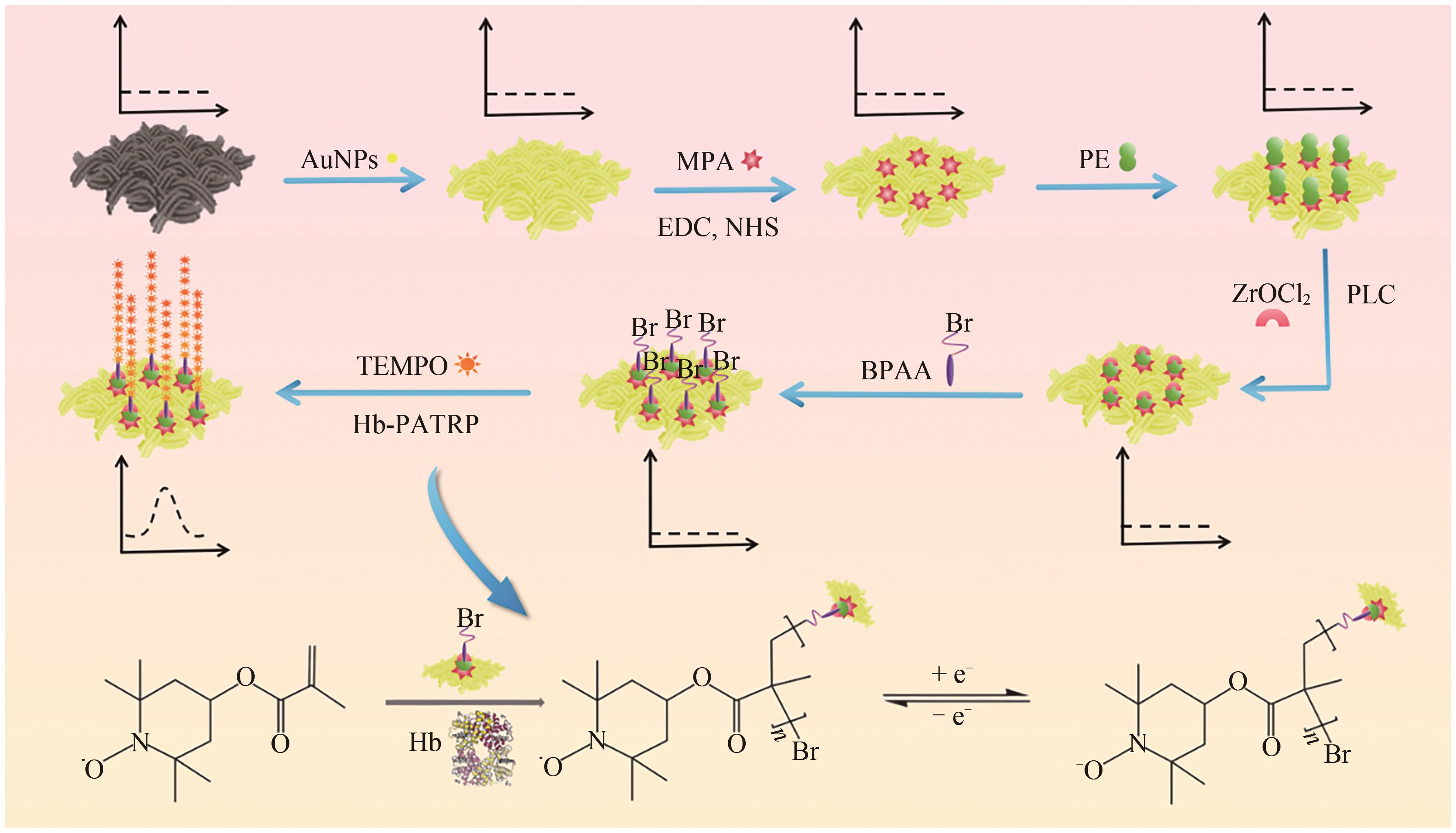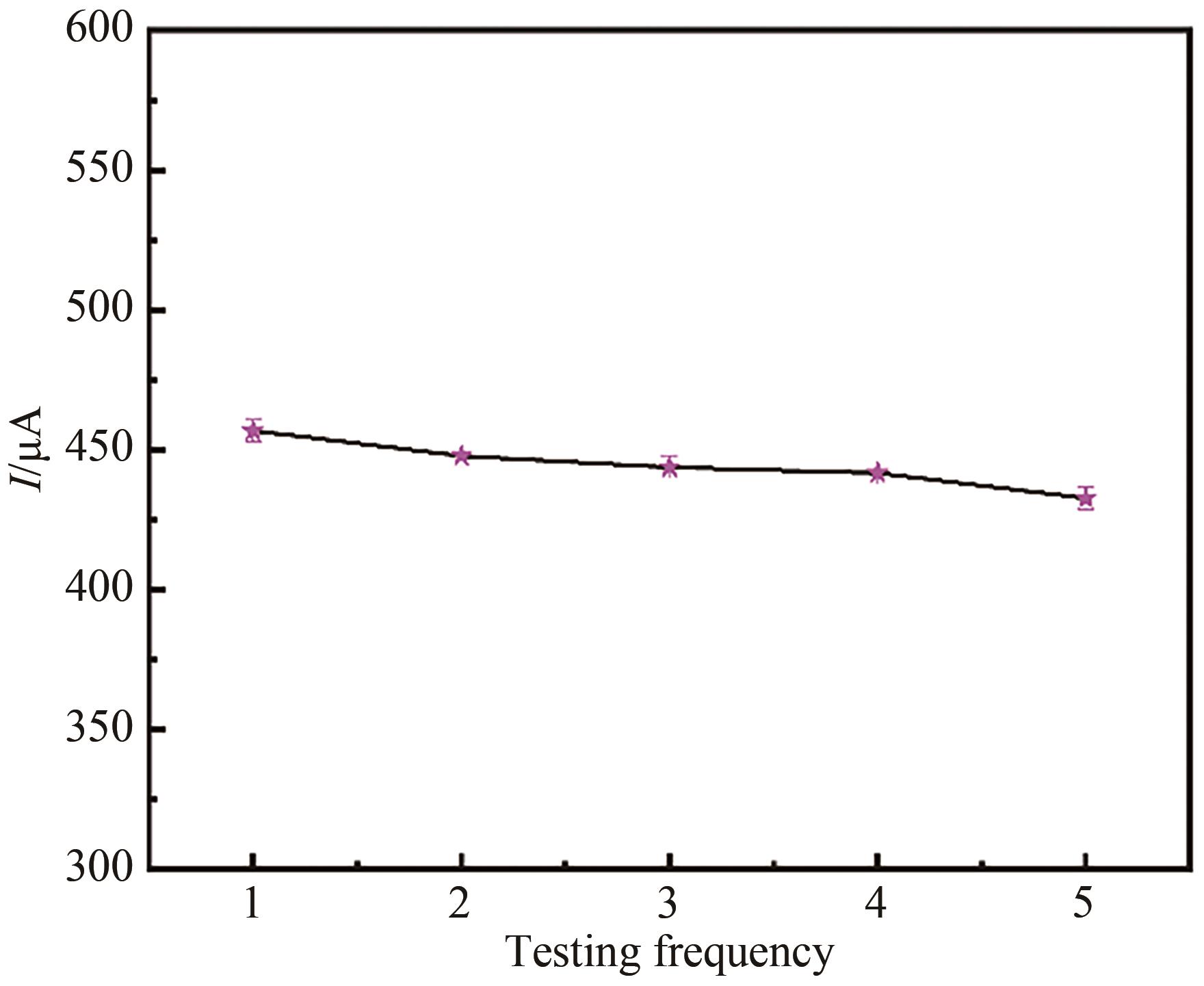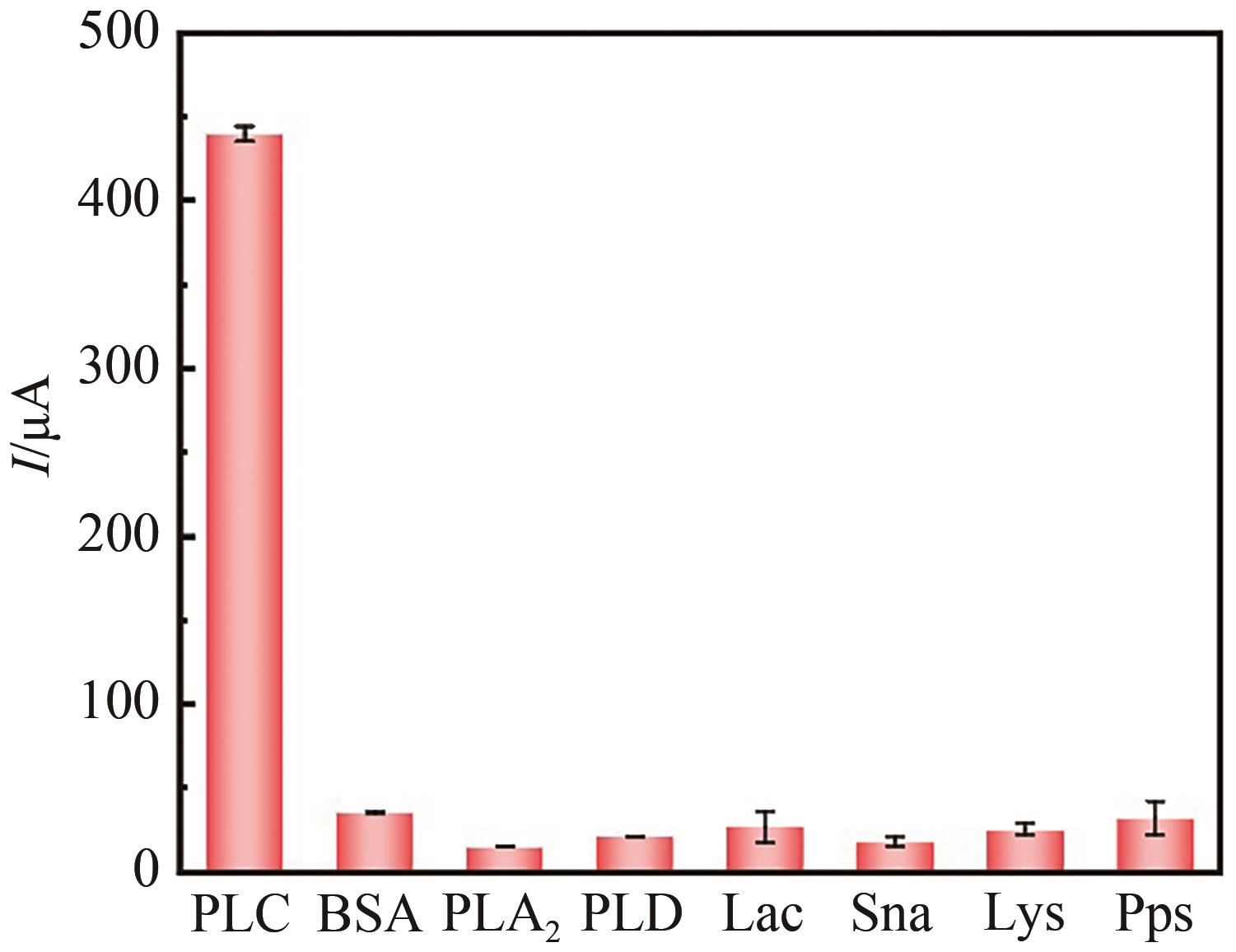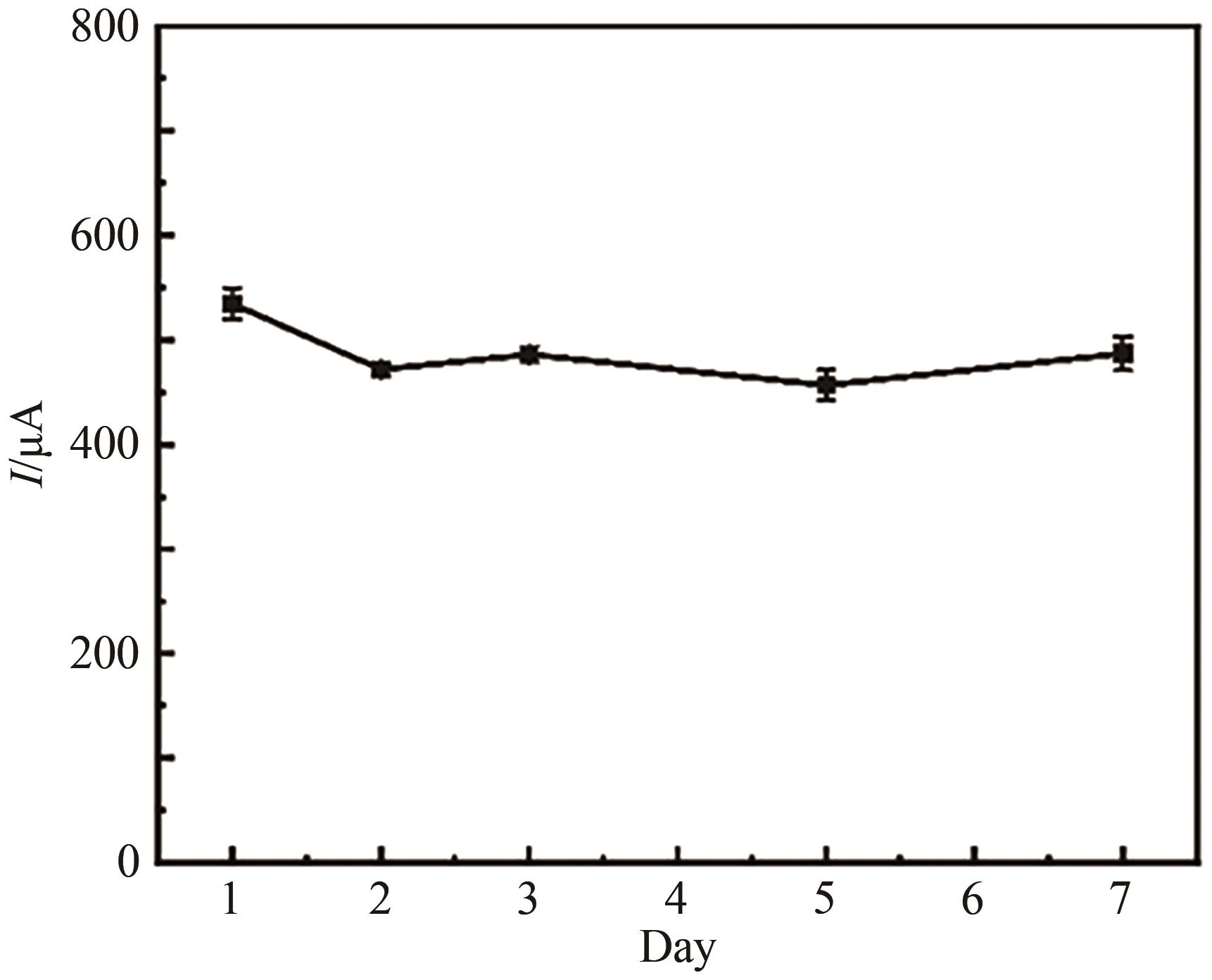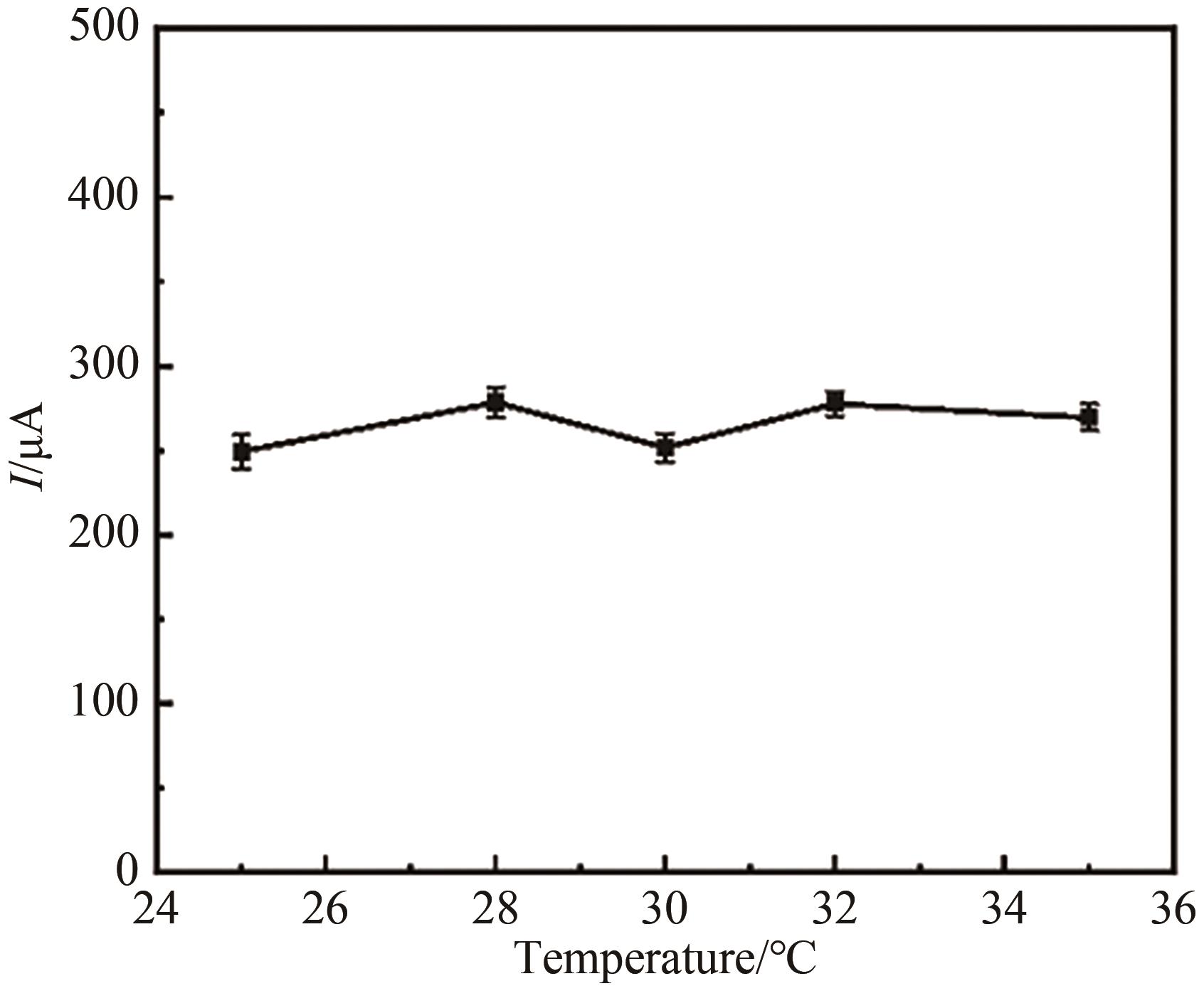
应用化学 ›› 2024, Vol. 41 ›› Issue (7): 987-997.DOI: 10.19894/j.issn.1000-0518.240026
基于柔性电极和信号放大技术构建检测磷脂酶C的电化学传感器
- 辽宁师范大学化学化工学院,大连 116029
-
收稿日期:2024-01-23接受日期:2024-05-21出版日期:2024-07-01发布日期:2024-08-03 -
通讯作者:孙越 -
作者简介:第一联系人:共同第一作者 -
基金资助:辽宁省自然科学基金(2021-MS-273);辽宁省教育厅服务地方项目(JYTMS20231091);国家级大学生创新创业训练计划项目(202210165027);辽宁省大学生创新创业训练计划项目(S202310165008X)
Fabrication of an Electrochemical Sensor for Phospholipase C Detection Based on Flexible Electrodes and Signal Amplification Technology
Yao-Yao WANG, Ming-Yang SUN, Zuan YANG, Shao-Kai DU, Yu-Xuan HE, Yue SUN( )
)
- College of Chemistry and Chemical Engineering,Liaoning Normal University,Dalian 116029,China
-
Received:2024-01-23Accepted:2024-05-21Published:2024-07-01Online:2024-08-03 -
Contact:Yue SUN -
About author:yue0411@163.com
-
Supported by:the Natural Science Foundation of Liaoning Province(2021-MS-273);the Service Local Projects of Liaoning Education Department(JYTMS20231091);the National College Students Innovation and Entrepreneurship Training Program(202210165027);the Innovation and Entrepreneurship Training Program for College Students in Liaoning Province(S202310165008X)
摘要:
磷脂酶C(PLC)是动植物中重要的脂质水解酶,在哺乳动物细胞的代谢、生长、炎症、分化、衰老和凋亡中起着重要作用,与许多癌症的发生、发展显著相关。 蛋白质催化原子转移自由基聚合(PATRP)是高分子设计、制备的有效手段,可通过链式反应将数百个电活性单体连接成一个高相对分子质量的聚合物链,从而使分子识别信号大大增强。 首先,在柔性碳布(CC)电极表面修饰纳米金(AuNPs),之后通过3-巯基丙酸、碳二亚胺盐酸盐和N-羟基丁二酰亚胺,将PLC的特异性底物磷脂酰乙醇胺(PE)固定在电极上,经过PLC对PE的特异性水解产生磷酸基团,引入Zr4+,通过Zr4+的配位作用将聚合引发剂α-溴苯乙酸修饰到电极表面,最后在蛋白质催化作用下进行2,2,6,6-四甲基哌啶氧化物(TEMPO)的PATRP聚合反应,在电极表面引入电活性聚合物分子链,构建信号放大型电化学传感器P(TEMPO)/PE/AuNPs/CC,用于磷脂酶C的高灵敏度检测。 结果表明,该传感器检测PLC的线性范围为10~1×105 mU/L,检出限为3.568 mU/L(S/N=3)。 与其他检测PLC的方法相比,该传感器具有较宽的检测范围和较低的检出限,且在检测实际乳腺癌细胞中的PLC方面有巨大的实际应用潜力。
中图分类号:
引用本文
王瑶瑶, 孙铭阳, 杨钻, 杜绍恺, 何禹璇, 孙越. 基于柔性电极和信号放大技术构建检测磷脂酶C的电化学传感器[J]. 应用化学, 2024, 41(7): 987-997.
Yao-Yao WANG, Ming-Yang SUN, Zuan YANG, Shao-Kai DU, Yu-Xuan HE, Yue SUN. Fabrication of an Electrochemical Sensor for Phospholipase C Detection Based on Flexible Electrodes and Signal Amplification Technology[J]. Chinese Journal of Applied Chemistry, 2024, 41(7): 987-997.
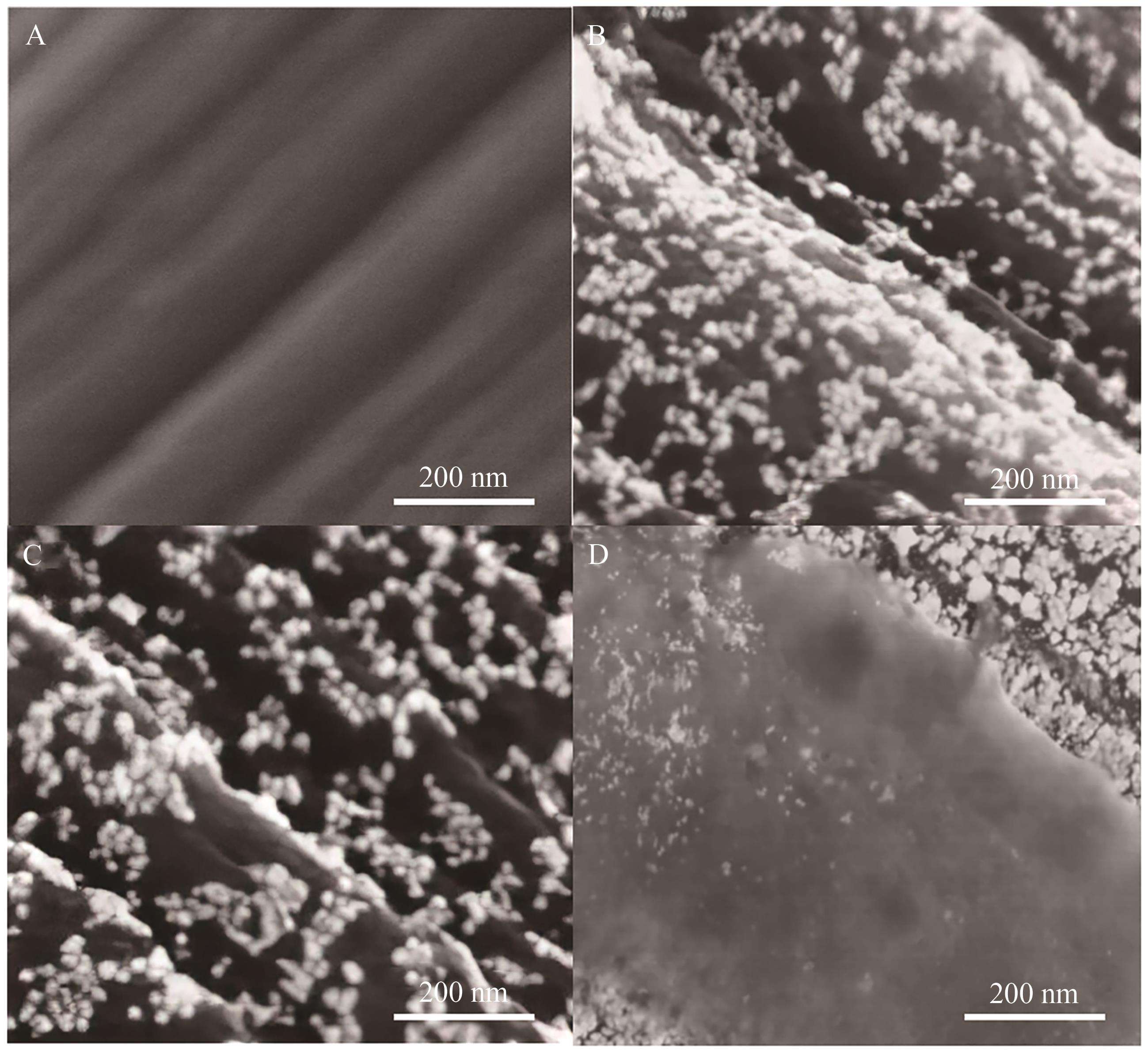
图2 (A)裸CC电极、(B) AuNPs/CC电极、(C) PE/AuNPs/CC电极和(D) P(TEMPO)/PE/AuNPs/CC电极的SEM图
Fig.2 SEM of bare carbon cloth (CC) electrode (A), AuNPs/CC electrode (B), PE/AuNPs/CC electrode (C) and P(TEMPO)/PE/AuNPs/CC electrode (D)
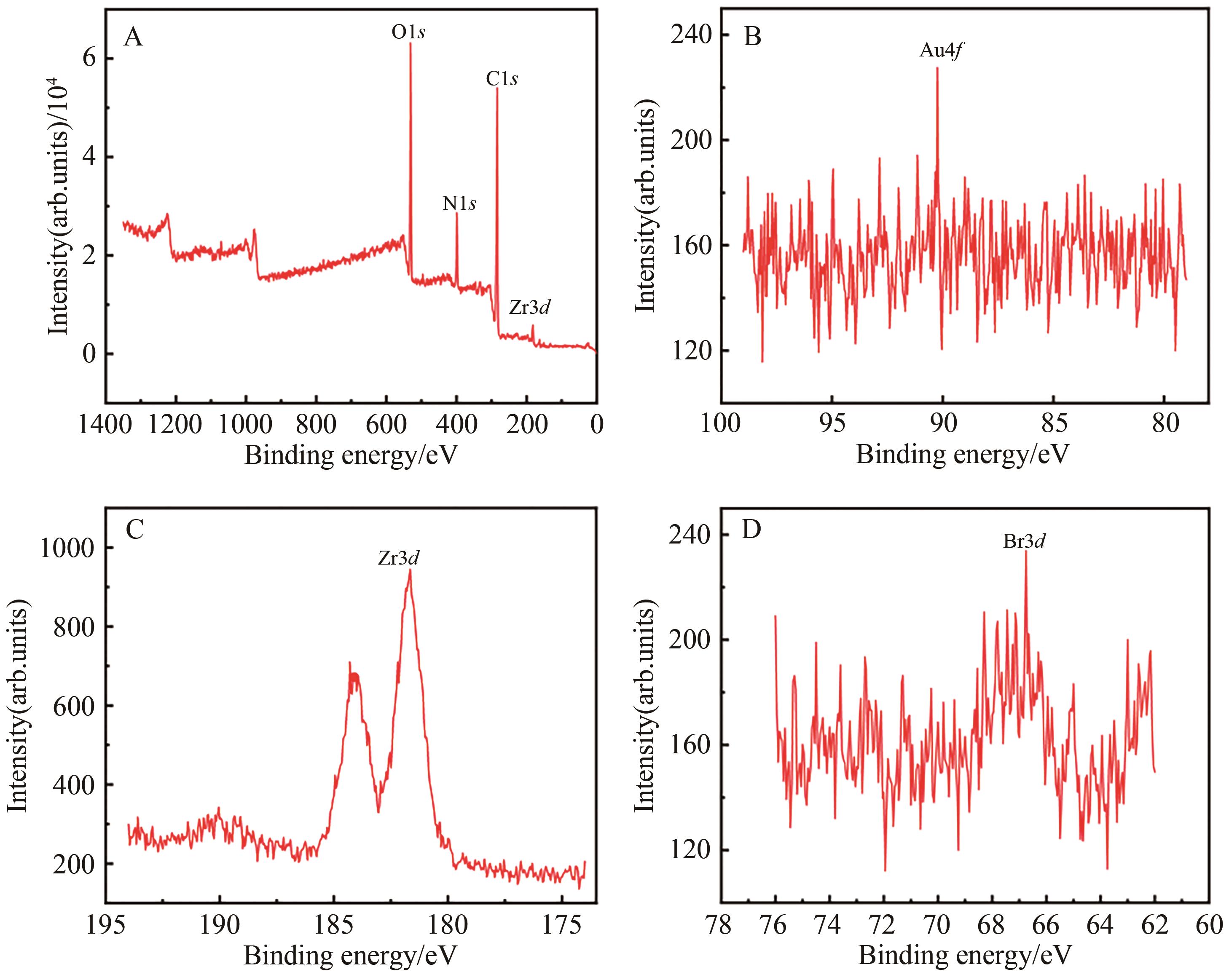
图3 P(TEMPO)/PE/AuNPs/CC修饰电极的XPS谱图(A)及Au(B)、Zr(C)和Br(D)的高分辨率光谱
Fig.3 XPS spectra of P(TEMPO)/PE/AuNPs/CC electrode (A) and high-resolution spectra of Au (B), Zr (C) and Br (D)
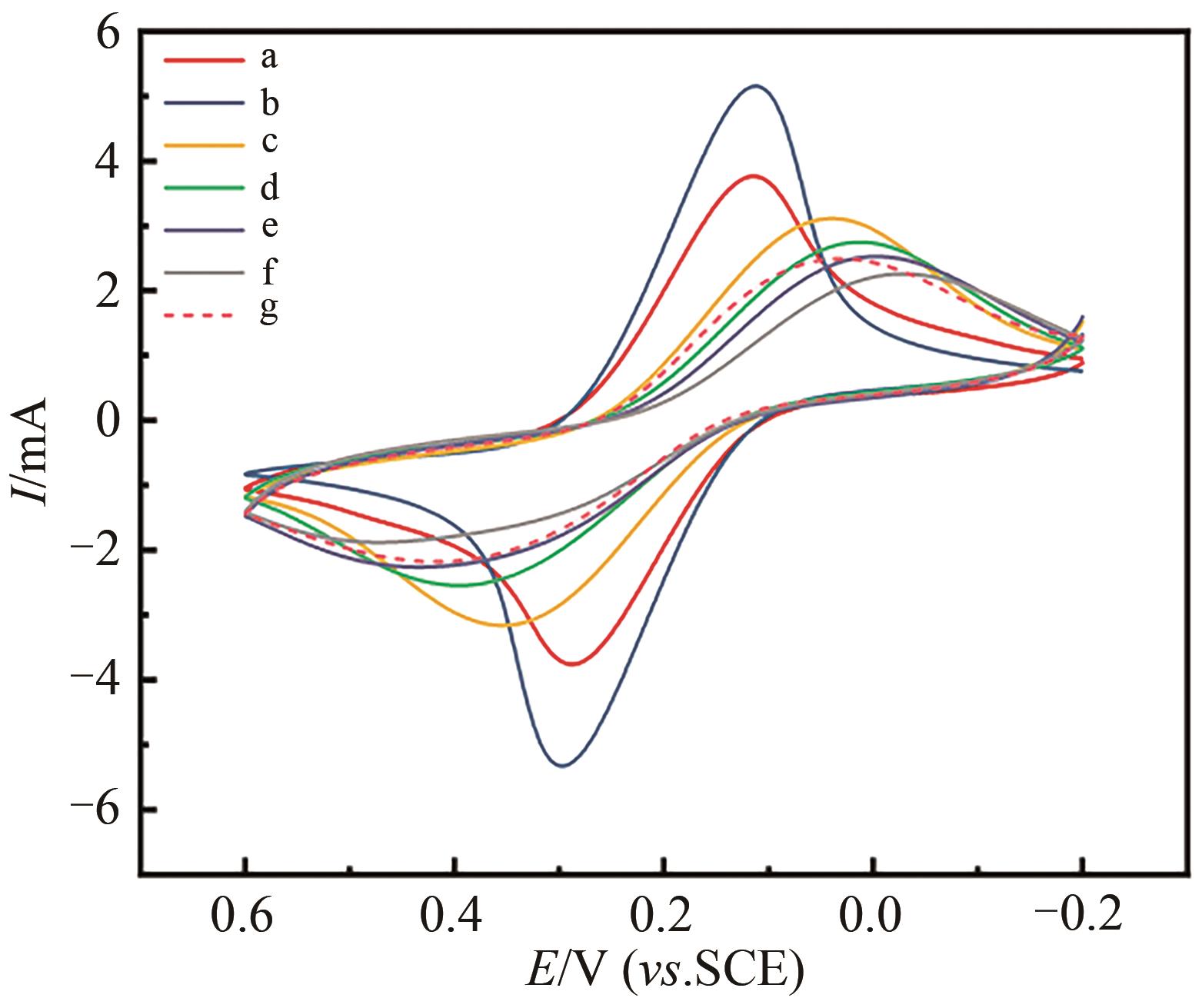
图4 不同修饰电极在0.1 mol/L KCl+5 mmol/L [Fe(CN)6]3-/4- 溶液中的CV图a. CC electrode; b. AuNPs/CC electrode; c. PE/AuNPs/CC electrode; d. PE (after hydrolysis)/AuNPs/CC electrode; e. Zr4+/AuNPs/CC electrode; f. BPAA/AuNPs/CC electrode; g. P(TEMPO)/PE/AuNPs/CC electrode
Fig.4 The CV of different modified electrodes in 0.1 mol/L KCl+5 mmol/L [Fe(CN)6]3-/4- solution
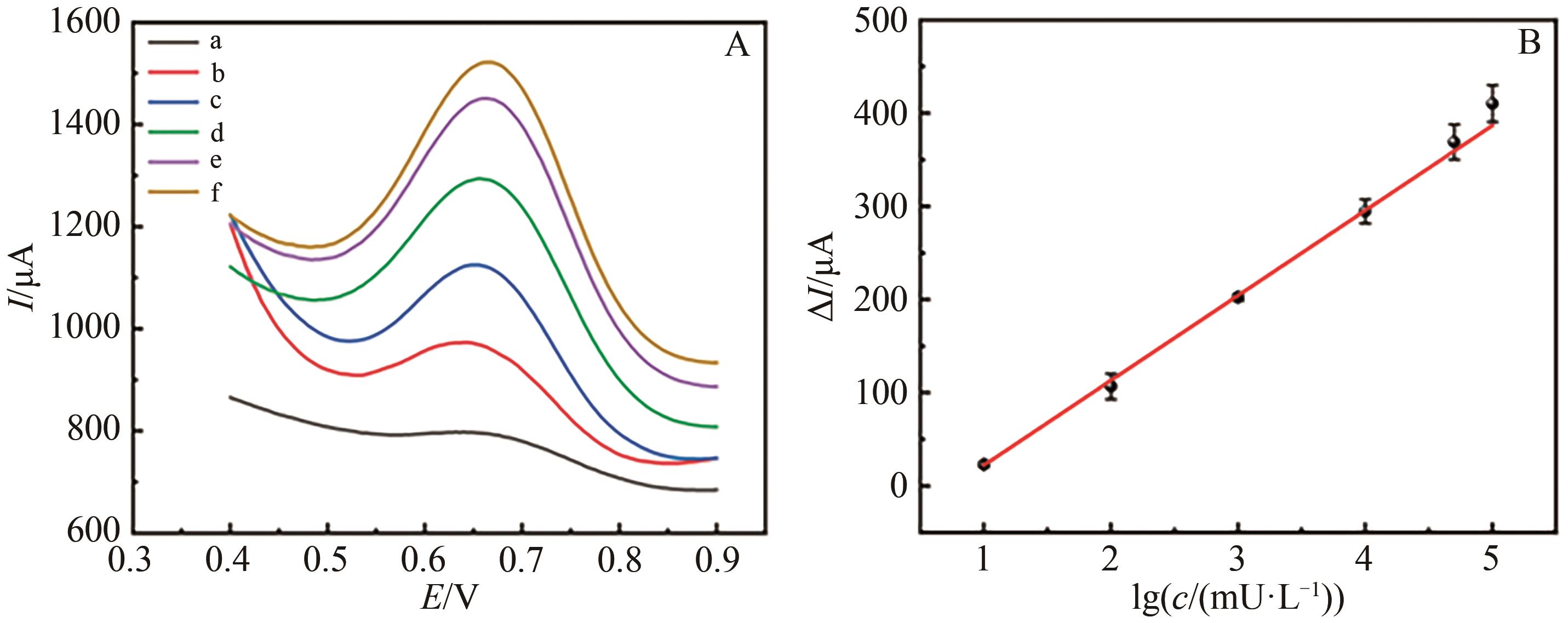
图5 (A)传感器在0.5 mol/L的LiClO4溶液中检测不同浓度PLC的SWV曲线(a-f对应PLC浓度分别是10、1×102、1×103、1×104、1×104.69和1×105 mU/L); (B)传感器检测PLC的工作曲线
Fig.5 (A) SWV curves of sensor in 0.5 mol/L LiClO4 solution to detect PLC with different concentrations (the curves from a to f correspond to PLC concentrations of 10, 1×102, 1×103, 1×104, 1×104.69 and 1×105 mU/L); (B) Working curve of PLC detected by sensor
| Detection method | Main materials | Linear range/ (nmol·L-1) | Detection limit/ (nmol·L-1) | Ref. |
|---|---|---|---|---|
| Fluorescence method | 11-Mercaptocarboxylic acid-gold nanodot-liposome hybrids | 0.5~50 | 0.21 | [43] |
| Fluorescence method | Fluorescently labeled liposomes | 6.75~4.05×102 | 2.7 | [44] |
| Liquid mass spectrometry | 1-Palmitoyl-2-oleoyl-diacylglycerol | 0~27.5 | 0.4 | [45] |
| Fluorescence method | Water-soluble conjugated polyelectrolyte-lipid complexes | 0~1×105 | 1 | [46] |
| Electrochemical method | P(TEMPO)/PE/AuNPs/CC-modified electrodes | 1.35×10-2~1.35×102 | 4.817×10-3 | This work |
表1 与其他分析方法的性能比较
Table 1 Performance comparison with other analysis methods
| Detection method | Main materials | Linear range/ (nmol·L-1) | Detection limit/ (nmol·L-1) | Ref. |
|---|---|---|---|---|
| Fluorescence method | 11-Mercaptocarboxylic acid-gold nanodot-liposome hybrids | 0.5~50 | 0.21 | [43] |
| Fluorescence method | Fluorescently labeled liposomes | 6.75~4.05×102 | 2.7 | [44] |
| Liquid mass spectrometry | 1-Palmitoyl-2-oleoyl-diacylglycerol | 0~27.5 | 0.4 | [45] |
| Fluorescence method | Water-soluble conjugated polyelectrolyte-lipid complexes | 0~1×105 | 1 | [46] |
| Electrochemical method | P(TEMPO)/PE/AuNPs/CC-modified electrodes | 1.35×10-2~1.35×102 | 4.817×10-3 | This work |
| 1 | SURATEKAR R, PANDA A, RAGHU P, et al. Evidence of sinks and sources in the phospholipase C-activated PIP2 cycle[J]. FEBS Lett, 2018, 592(6): 962-972. |
| 2 | FUKAMI K, INANOBE S, KANEMARU K, et al. Phospholipase C is a key enzyme regulating intracellular calcium and modulating the phosphoinositide balance[J]. Prog Lipid Res, 2010, 49(4): 429-437. |
| 3 | KANEMARU K, NAKAMURA Y. Activation mechanisms and diverse functions of mammalian phospholipase C[J]. Biomolecules, 2023, 13(6): 915. |
| 4 | SINGH V, RAI R, MATHEW B J, et al. Phospholipase C: underrated players in microbial infections[J]. Front Cell Infect Microbiol, 2023, 13: 1089374. |
| 5 | EURTIVONG C, LEUNG E, SHARMA N, et al. Phosphatidylcholine-specific phospholipase C as a promising drug target[J]. Molecules, 2023, 28(15): 5637. |
| 6 | SALUCCI S, ARAMINI B, BARTOLETTI-STELLA A, et al. Phospholipase family enzymes in lung cancer: looking for novel therapeutic approaches[J]. Cancers, 2023, 15(12): 3245. |
| 7 | SEO E B, JANG H J, KWON S H, et al. Loss of phospholipase Cγ1 suppresses hepatocellular carcinogenesis through blockade of STAT3-mediated cancer development[J]. Hepatol Commun, 2022, 6(11) :3234-3246. |
| 8 | LI X, MENG P, SUN M, et al. An ultrasensitive electrochemical sensor for phospholipase C via signal amplification based on breathing ATRP and its application[J]. Analyst, 2023, 148(10): 2352-2361. |
| 9 | LI X, YANG Z, MENG P, et al. Ultrasensitive electrochemical detection of phospholipase C via dual signal amplification based on MVL ATRP and silver nanoparticles[J]. Microchem J, 2023, 191: 108847. |
| 10 | 李宇轩, 陈婷, 李鲁艳, 等. 碳布基树枝状PbO2在H2O2电化学传感器中的应用[J]. 山东建筑大学学报, 2023, 38(1): 95-101. |
| LI Y X, CHEN T, LI L Y, et al. Application of carbon cloth based dendritic PbO2 in H2O2 electrochemical sensor[J].J Shandong Jianzhu Univ, 2023, 38(1): 95-101. | |
| 11 | 马闯, 高娟娟, 张树鹏, 等. 基于不同工作电极的亚硝酸盐电化学传感器[J]. 大学化学, 2018, 33(6): 1-10. |
| MA C, GAO J J, ZHANG S P, et al. Electrochemical sensors for nitrite based on different working electrodes[J]. Univ Chem, 2018, 33(6): 1-10. | |
| 12 | TORRINHA Á, MORAIS S. Electrochemical (bio) sensors based on carbon cloth and carbon paper: an overview[J]. Trends Environ Anal, 2021, 142: 116324. |
| 13 | SARKAR P K, KAMILYA T, ACHARYA S. Introduction of triboelectric positive bioplastic for powering portable electronics and self-powered gait sensor[J]. ACS Appl Energ Mater, 2019, 2(8): 5507-5514. |
| 14 | DE PENNING R, MONZON N, PADALKAR S. Flexible zinc oxide-based biosensors for detection of multiple analytes[J]. Mater Res, 2022, 37: 2942-2950. |
| 15 | ZHOU Y, LV Y, DONG H, et al. Ultrasensitive assay of amyloid-beta oligomers using Au-vertical graphene/carbon cloth electrode based on poly(thymine)-templated copper nanoparticles as probes[J]. Sens Actuators B: Chem, 2021, 331:129429. |
| 16 | SHI J, LIN Y, QIN W, et al. Superior performance of a graphdiyne self-powered biosensor with exonuclease Ⅲ-assisted signal amplification for sensitive detection of microRNAs[J]. Analyst, 2022, 147(22): 4991-4999. |
| 17 | LIU Q, JIAN L, LIU R, et al. Metal-free photoinduced atom transfer radical polymerization for highly sensitive detection of lung cancer DNA[J]. Chem-Eur J, 2020, 26(7): 1633-1639. |
| 18 | APATA I E, TAWADE B V, CUMMINGS S P, et al. Comparative study of polymer-grafted BaTiO3 nanoparticles synthesized using normal ATRP as well as ATRP and ARGET-ATRP with sacrificial initiator with a focus on controlling the polymer graft density and molecular weight[J]. Molecules, 2023, 28(11): 4444. |
| 19 | LI S Y, SCHON B S, TRAVAS-SEJDIC J. Grafting of porous conductive fiber mats with an antifouling polymer brush by means of filtration-based surface initiated ATRP[J]. Macromol Rapid Commun, 2023: 2300069. |
| 20 | RONG L, SANTRA A, ROSS G, et al. Polymer grafted graphene via atom transfer radical polymerization (ATRP): a rheology improver in oil-based drilling fluids[J]. Mrs Commun, 2023, 13(3): 445-450. |
| 21 | LI R, AN Z. Achieving ultrahigh molecular weights with diverse architectures for unconjugated monomers through oxygen-tolerant photoenzymatic RAFT polymerization[J]. Angew Chem Int Ed, 2020, 59(49): 22258-22264. |
| 22 | ARONOVA M A, BYRNES C, LEE Y T, et al. Quantitative stem-eels imaging of ferritin distributions in cultured erythroblasts undergoing erythropoiesis[J]. Microsc Microanal, 2018, 24(S1): 2034-2035. |
| 23 | REEDER B J. The redox activity of hemoglobins: from physiologic functions to pathologic mechanisms[J]. Antioxid Redox Sign, 2010, 13(7): 1067-1123. |
| 24 | LIN S D, YOHANNES Y B, HWANG B J, et al. The effect of 2,2,6,6-tetramethylpiperidinyl-oxide (TEMPO) as an electrolyte additive and its SEI formation on Mcmb-Electrode[J]. ECS Trans, 2020, 97(7): 135. |
| 25 | 梁华哲. 聚酰胺胺负载TEMPO的制备及其催化氧化性能[D]. 石家庄: 河北科技大学, 2020. |
| LIANG H Z. Preparation of polyamide amine-supported TEMPO and its catalytic oxidation performance[D]. Shijiazhuang: Hebei University of Science and Technology, 2020. | |
| 26 | 饶春美, 高致远, 徐玉兵, 等. 双抗体夹心法测定血清YKL-40在肝硬化中的诊断价值研究[J]. 现代免疫学, 2017, 37(4): 313-316. |
| RAO C M, GAO Z Y, XU Y B, et al. Diagnostic value of double-antibody sandwich ELISA for serum YKL-40 in patients with liver cirrhosis.[J]. Curr Immunol, 2017, 37(4): 313-316. | |
| 27 | WANG S, MENG H, LI Y, et al. Polymer brushes grafted from graphene via bioinspired polydopamine chemistry and activators regenerated by electron transfer atom transfer radical polymerization[J]. J Polym Sci Pol Chem, 2019, 57(6): 689-698. |
| 28 | SU H L, YANG M M, ZHAO L M, et al. Recyclable magnetic Fe3O4 supported photocatalyst for the metal-free ATRP[J]. Eur Polym J, 2022, 177: 111476. |
| 29 | BESPALOV I, DATLER M, BUHR S, et al. Initial stages of oxide formation on the Zr surface at low oxygen pressure: an in situ FIM and XPS study[J]. Ultramicroscopy, 2015, 159: 147-151. |
| 30 | LI X, CHEN Z, CHEN Z, et al. An experimental and theoretical study on the photoluminescence of O and Br co-doped ZnS quantum dots synthesized by a solid-state reaction method[J]. J Alloy Compd, 2020, 845: 155405. |
| 31 | CHAPMAN P, DUCKER R E, HURLEY C R, et al. Fabrication of two-component, brush-on-brush topographical microstructures by combination of atom-transfer radical polymerization with polymer end-functionalization and photopatterning[J]. Langmuir, 2015, 31(21): 5935-5944. |
| 32 | SUN H, QIU Y, LU Y, et al. Ultrasensitive DNA electrochemical biosensor based on MnTBAP biomimetic catalyzed AGET ATRP signal amplification reaction[J]. Chem Commun, 2020, 56: 6636-6639. |
| 33 | AHMADPOUR S, TASHKHOURIAN J, HEMMATEENEJAD B. A chemometric investigation on the influence of the nature and concentration of supporting electrolyte on charging currents in electrochemistry[J]. J Electroanal Chem, 2020, 871: 114296. |
| 34 | GUO W, YIN Y X, XIN S, et al. Superior radical polymer cathode material with a two-electron process redox reaction promoted by graphene[J]. Energ Environ Sci, 2012, 5(1): 5221-5225. |
| 35 | WEI Y C, LI Y C, CHUNG M O, et al. Synthesis of fluorescent gold nanodot-liposome hybrids for detection of phospholipase C and its inhibitor[J]. Anal Chem, 2013, 85(18): 8834-8840. |
| 36 | TORLEY L, SILVERSTRIM C, PICKETT W. A turbidometric assay for phospholipase C andsphingomyelinase[J]. Anal Biochem, 1994, 222(2): 461-464. |
| 37 | MURAKAMI C, MIZUNO S, KADO S, et al. Development of a liquid chromatography-mass spectrometry based enzyme activity assay for phosphatidylcholine-specific phospholipase C[J]. Anal Biochem, 2017, 526: 43-49. |
| 38 | LIU Y, OGAWA K, SCHANZE K S. Conjugated polyelectrolyte based real-time fluorescence assay for phospholipase C[J]. Anal Chem, 2008, 80(1): 150-158. |
| [1] | 姜士鹏, 周禹希, 孟沛然, 谢炎轩, 宋祉怡, 赵洹影, 孙越. 基于无金属可见光诱导原子转移自由基聚合方法制备人血清白蛋白超微印迹传感器及其性能[J]. 应用化学, 2023, 40(2): 299-308. |
| [2] | 李东东, 秦丽, 唐录华, 高文惠. 碱性橙Ⅱ印迹传感器的制备及其应用[J]. 应用化学, 2022, 39(7): 1052-1064. |
| [3] | 邵姗, 张剑, 邓凯强, 杨杰, 杨绍明. 镍钴双金属-卟啉有机框架复合纳米材料构建的无酶传感器检测多巴胺[J]. 应用化学, 2022, 39(7): 1098-1107. |
| [4] | 王伟, 李娟, 白茹, 韩珍, 冯雪薇, 孙越. 无金属可见光诱导原子转移自由基聚合法制备聚丙烯酰胺@氧化石墨烯/纳米钯复合物修饰电极及其对乙醇的检测[J]. 应用化学, 2020, 37(5): 595-603. |
| [5] | 秦思楠, 唐录华, 高文惠. 三氟氯氰菊酯分子印迹电化学传感器的制备及性能研究与应用[J]. 应用化学, 2019, 36(8): 958-967. |
| [6] | 刘雨桐,赵梦元,李思雨,杨艺菲,孙越. 超氧化物歧化酶催化-电化学调控的原子转移自由基聚合方法制备分子印迹聚合物[J]. 应用化学, 2019, 36(5): 585-594. |
| [7] | 杨木泉, 肖凌宇, 张旋, 颜悦. Au/聚4-乙烯基吡啶-b-聚乙二醇嵌段聚合物刷的合成及其pH响应行为[J]. 应用化学, 2019, 36(4): 431-439. |
| [8] | 邢陈丽, 王晶, 张朝晖, 谢丹丹, 吕飘飘. 氧化石墨烯/富勒烯复合材料增敏多金属离子印迹电化学传感器[J]. 应用化学, 2019, 36(3): 341-348. |
| [9] | 袁若鑫, 刘新刚, 张楚虹. 二氧化锡/石墨烯柔性电极的制备及其在锂离子电池中的应用[J]. 应用化学, 2018, 35(7): 825-833. |
| [10] | 丁昊, 晏菲, 郑雯静, 郭维亮, 苏彬. 二氧化硅纳米均孔膜修饰电极检测化妆水中的抗氧化剂[J]. 应用化学, 2017, 34(11): 1307-1313. |
| [11] | 丁昊, 晏菲, 郑雯静, 郭维亮, 苏彬. 二氧化硅纳米均孔膜修饰电极检测化妆水中的抗氧化剂[J]. 应用化学, 2017, 34(11): 0-0. |
| [12] | 刘亚柳, 袁中直, 刘俐伶. 二氧化锰/石墨烯纸电极的制备及其电化学性能[J]. 应用化学, 2015, 32(7): 843-848. |
| [13] | 黄雪红, 林娟, 郑榕学, 林艺凤, 丁富传, 凌启淡. 原子转移自由基聚合法制备侧链型磺化聚醚醚酮阳离子交换膜[J]. 应用化学, 2014, 31(08): 878-884. |
| [14] | 陈敏, 邓之俊, 张丽本, 李小刚. 碱性离子液体催化金属调节的甲基丙烯酸甲酯的电子转移活化原子转移自由基聚合[J]. 应用化学, 2014, 31(05): 553-559. |
| [15] | 刘蓉, 钟桐生, 龙立平, 尹志芳, 曹伟. 氯丙嗪分子印迹敏感膜传感器的制备与应用[J]. 应用化学, 2013, 30(11): 1361-1365. |
| 阅读次数 | ||||||
|
全文 |
|
|||||
|
摘要 |
|
|||||
